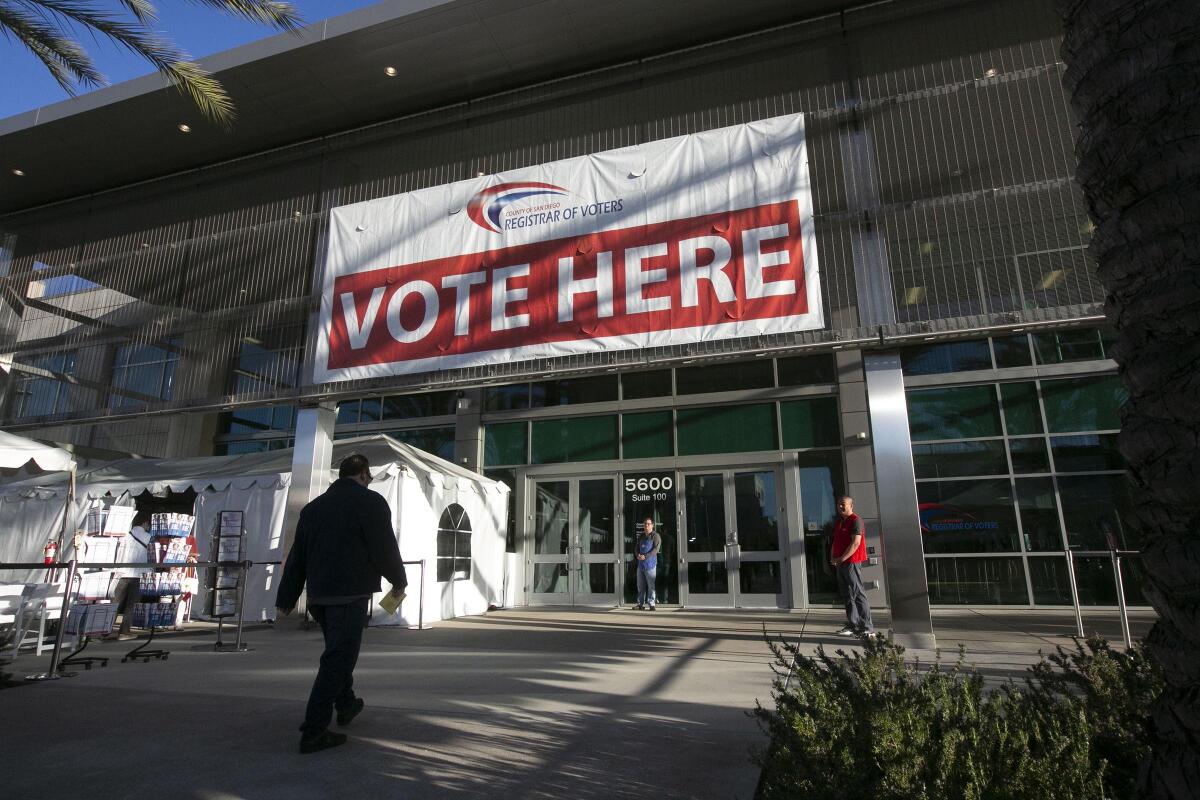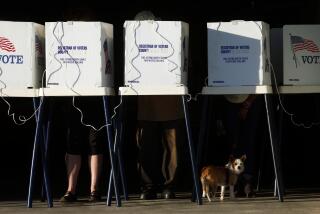Millions skipped California’s 2020 primary. Will coronavirus change who votes in November?

- Share via
SACRAMENTO — California’s 2020 presidential primary officially entered the history books Friday, as state officials certified a final tally and a rate of voter turnout that, while one of the highest in recent elections, still saw fewer than half of the state’s registered voters cast a ballot.
In all, 46.89% of registered voters cast ballots in the March 3 primary, which was moved up from June with hopes that turnout would be high and presidential candidates would be forced to address issues mattering most to Californians. Turnout was noticeably lower in Los Angeles County, where 38% of voters showed up. It was one of three counties tied for the second-lowest turnout in the state.
While both the 2016 and 2008 primaries saw a higher percentage of registered voters participate, California Secretary of State Alex Padilla focused on the almost 9.7 million ballots cast, only behind the total number in 2008.
“If we look at the participation, it was the second-highest in almost 40 years,” he said. “I think we continue to see the impact from several of the voting reforms we’ve championed.”
Vermont Sen. Bernie Sanders won the Democratic presidential primary statewide with 36% support, followed by former Vice President Joe Biden at 27.9%. But most of the Democratic Party’s delegates were awarded by congressional district, with Biden and Sanders winning support in each of the state’s 53 districts. Massachusetts Sen. Elizabeth Warren won delegate votes in nine districts, while former New York City Mayor Michael R. Bloomberg won votes in seven districts.
The early primary may not earn a place in the history books for voter enthusiasm, but it might be remembered as California’s last major civic event of the pre-coronavirus era. The likelihood that the pandemic lingers well into the fall has convinced a wide swath of elections experts that California must mail a ballot to each of the state’s 20.6 million voters for the November general election.
In short, they want to encourage voters to show up by staying home.
“There is no way that any Californians should have to risk their health and possibly their life to exercise the right to vote,” Assemblyman Marc Berman (D-Palo Alto) said.
Berman has introduced legislation to require counties to mail every registered voter a ballot for the Nov. 3 election, a one-time change in response to public health guidelines for physical distancing. Lawmakers, who will reconvene in Sacramento next week on a limited work schedule, will consider the proposal later this month.
Fourteen counties already mail a ballot to every voter under provisions of a 2016 law that swaps new “vote centers” for traditional neighborhood polling places. L.A. County, which was allowed this year to join that system without mailing all voters a ballot, is now poised to do so for November after the March election saw widespread problems including long lines at in-person vote centers that are now being investigated by auditors.
But millions more still prefer voting on election day, despite an almost two-decades-old state law that allows anyone to become a permanent absentee voter for any reason. And because voter turnout is traditionally higher in general elections, a temporary shift to all-mail voting could create significant work for elections officials and voting rights groups.
“Given the COVID-19 pandemic, I absolutely believe we should mail every voter a ballot in California,” Padilla said Friday. “We have six months to educate the public.”
Potential disagreements are already developing between local and state elections officials over the extent to which absentee voting should be the only option. The California Assn. of Clerks and Election Officials wrote to Gov. Gavin Newsom last month to request changes to sharply limit in-person voting and to give new discretion to counties on how it would be handled.
“Finding suitable voting locations that will allow for proper social distancing and space for line queuing, issuing, voting and receiving ballots will be extremely challenging. The safety and health of the voters, poll workers and county employees are of the utmost importance,” Joseph Holland, the registrar of voters in Santa Barbara County and the association’s president, wrote in the April 13 letter.
But Padilla said Friday that options must be available.
“It’s important to maintain, and I’m committed to maintaining, as many in-person voting locations as possible,” he said in an interview.
A shift to sending every voter a ballot to be cast remotely — and expecting it will be — could also put enormous pressure on vote counting. A variety of California laws have allowed voters as much leeway as possible for returning ballots at the last minute. Millions more of these late votes, cast by citizens who aren’t sure of their choices until the final hours, could prove problematic.
“The COVID-19 infection curve is not the only curve we need to flatten. We need to flatten the voting curve,” said Kim Alexander, president of the nonpartisan California Voter Foundation. “We need to encourage people to stagger their return of those ballots.”
The influx of 11th-hour ballots could be unprecedented. Rob Pyers, the research director of the nonpartisan California Target Book, pointed out last month in a social media posting that historical data from previous November elections suggest some 6 million ballots could remain uncounted on election day. In their letter to Newsom, elections officials asked him to extend the number of days they have to count ballots, similar to the extension he ordered for the March election.
Whether turnout for the March election met the expectations of those who championed an early presidential primary is unclear. A slightly larger share of the state’s registered voters participated in the 2016 primary, many showing up for that year’s race between Democrats Hillary Clinton and Sanders. The highest turnout for a presidential primary in the last quarter of a century was in February 2008 when Clinton beat then-Illinois Sen. Barack Obama in the Democratic primary and Sen. John McCain won the Republican contest.
The 2008 primary was unique, though, in that both major political parties had competitive primaries. Not so this time, Alexander said.
“The March primary wasn’t for everyone,” she said. “There’s a question as to how much you can expect turnout will increase when there’s only one partisan primary at stake.”
But Alexander pointed out that even interested voters could have been left out in numbers large enough to make a difference. Unaffiliated voters, who are registered with “no party preference,” had to take special action to be able to cast a ballot in the Democratic primary and were excluded from the GOP contest. But not all of those voters realized the need for an additional step until the end, when some communities — not just in Los Angeles — experienced long lines in the hours just before the polls closed on March 3.
“It’s not a surprise people are going to be deterred by all of that,” she said.
Key to the efforts to move most, or close to all, voters to participating remotely in November is the cost.
Counties, whose leaders have long criticized state leaders for imposing election mandates without also providing enough funding, are under enormous fiscal pressures from public health efforts to lessen the spread of the coronavirus. Sending more ballots by mail incurs costs related to postage — including the state law requiring prepaid return postage — and means possible delays by the U.S. Postal Service could further affect the need for elections workers to count those ballots long after election day.
“It’s now my job to advocate for as much funding as possible,” said Berman, whose legislation to make the change has not yet been reviewed for potential costs. “That’s going to be very difficult.”
More to Read
Sign up for Essential California
The most important California stories and recommendations in your inbox every morning.
You may occasionally receive promotional content from the Los Angeles Times.











